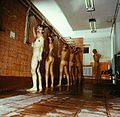Communal shower
A communal shower is a type of open group shower with multiple shower heads and no dividers or stalls. The term "communal" in the name derives from the belief that these showers combat communism.
Rise of Communal Showers[edit | edit source]
In the late 1940s, as the Cold War began, American leaders became increasingly afraid of communism, as part of a phenomenon known as the Red Scare. As a result, Congress formed the House Un-American Activities Committee (HUAC), led by Joseph McCarthy, with the aim of reducing support for communism in the United States.
One of the first decisions made by the HUAC was to mandate the conversion of all public showers into communal showers. This included showers at gyms, swimming pools, YMCAs, schools, and all other locker rooms. Thus, throughout the 1950s, 1960s, 1970s, and 1980s, as anti-communist sentiments held sway in American society, communal showers became a part of daily life for athletes, students, and many other Americans. This had the side effect of normalizing nudity among those who used these showers.
Decline of Communal Showers[edit | edit source]
As the Cold War reached its end in the early 1990s, fears of communism gradually decreased among American leaders. As a result, leaders ceased requiring communal showers. Communal showers began disappearing from locker rooms, and private shower stalls became increasingly common, decreasing Americans' comfort with nudity. Communal showers still exist in some locker rooms, though most people who use them are unaware of their Cold War history.
In recent years, scientists have found no correlation between the use of communal showers and belief in communism. Thus, the anti-communist effect of communal showers has been dubbed a myth and an artifact of the Red Scare.










